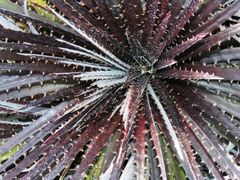Dyckia: Difference between revisions
just a start! |
m Reverted edits by ClarkStella (Talk) to last revision by Raffi |
||
| (8 intermediate revisions by 3 users not shown) | |||
| Line 1: | Line 1: | ||
{{SPlantbox | |||
| | |familia=Bromeliaceae | ||
| | |genus=Dyckia | ||
| | |common_name=Sawblade | ||
| | |habit=shrub | ||
| | |Min ht box=1 | ||
| | |Min ht metric=ft | ||
| | |Max ht box=4 | ||
| | |Max ht metric=ft | ||
| | |Min wd box=8 | ||
| | |Min wd metric=in | ||
| | |Max wd box=10 | ||
| | |Max wd metric=ft | ||
| | |origin=C & S America, incl. Brazil & Chile | ||
| | |lifespan=perennial | ||
| | |exposure=sun | ||
| | |water=moderate, dry | ||
| | |features=hummingbirds, drought tolerant | ||
|flower_season=early spring, mid spring, late spring | |||
| | |Min Temp Num=-5 | ||
| | |Temp Metric=°F | ||
| | |min_zone=8 | ||
| | |max_zone=11 | ||
| | |image=DyckiaDarkStarWb5006.JPG | ||
| | |image_width=240 | ||
}} | }} | ||
Dyckia (after Prince Salm-Dyck, German botanist, and author of a great work on succulent plants). Bromeliaceae. Succulents, grown under glass and in the open in mild winter climates. | |||
Dyckia (after Prince Salm-Dyck, German botanist, and author of a great work on succulent plants). Bromeliaceae. Succulents, grown under glass and in the open | |||
Dyckias | Dyckias are almost entirely terrestrial Bromeliads, usually stemless, with the leaves forming dense rosettes. Mature plants of some species may consist of hundreds of individual rosettes, forming dome-shaped clusters several feet high and wide. There are about 100 known species, most native to Brazil and other parts of South and Central America. The leaves are toothed, inspiring the common name, Sawblade. The flowers appear on spikes emerging from the side of the rosette and may be red, orange, or yellow. The flowers are attractive to hummingbirds, bees, and wasps. | ||
==Cultivation== | ==Cultivation== | ||
Full sun, loose, well-drained soil. Moderate to plentiful water when actively growing, very drought tolerant once established. Protect from temperatures below 18-25F, depending on species. | |||
===Propagation=== | ===Propagation=== | ||
By seed or offset. | |||
===Pests and diseases=== | ===Pests and diseases=== | ||
Root rot if overwatered during cold weather. Scale insects. Slugs or snails may attack the flower stems. | |||
==Species== | ==Species== | ||
| Line 68: | Line 57: | ||
*{{wplink}} | *{{wplink}} | ||
__NOTOC__ | |||
Latest revision as of 00:30, 10 July 2010
| Dyckia subsp. var. | Sawblade | |||||||||||||||||||||||||||||||||||||||||||||||||||||||
|---|---|---|---|---|---|---|---|---|---|---|---|---|---|---|---|---|---|---|---|---|---|---|---|---|---|---|---|---|---|---|---|---|---|---|---|---|---|---|---|---|---|---|---|---|---|---|---|---|---|---|---|---|---|---|---|---|

|
|
| ||||||||||||||||||||||||||||||||||||||||||||||||||||||
| ||||||||||||||||||||||||||||||||||||||||||||||||||||||||
Dyckia (after Prince Salm-Dyck, German botanist, and author of a great work on succulent plants). Bromeliaceae. Succulents, grown under glass and in the open in mild winter climates.
Dyckias are almost entirely terrestrial Bromeliads, usually stemless, with the leaves forming dense rosettes. Mature plants of some species may consist of hundreds of individual rosettes, forming dome-shaped clusters several feet high and wide. There are about 100 known species, most native to Brazil and other parts of South and Central America. The leaves are toothed, inspiring the common name, Sawblade. The flowers appear on spikes emerging from the side of the rosette and may be red, orange, or yellow. The flowers are attractive to hummingbirds, bees, and wasps.
Cultivation
Full sun, loose, well-drained soil. Moderate to plentiful water when actively growing, very drought tolerant once established. Protect from temperatures below 18-25F, depending on species.
Propagation
By seed or offset.
Pests and diseases
Root rot if overwatered during cold weather. Scale insects. Slugs or snails may attack the flower stems.
Species
Gallery
If you have a photo of this plant, please upload it! Plus, there may be other photos available for you to add.
-
photo 1
-
photo 2
-
photo 3
References
- Standard Cyclopedia of Horticulture, by L. H. Bailey, MacMillan Co., 1963
External links
- w:Dyckia. Some of the material on this page may be from Wikipedia, under the Creative Commons license.
- Dyckia QR Code (Size 50, 100, 200, 500)
